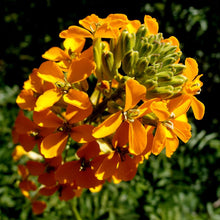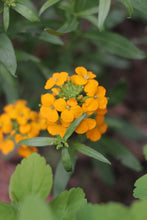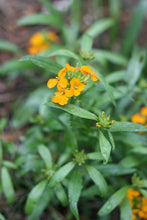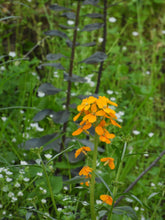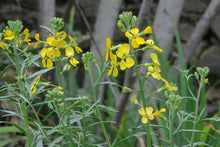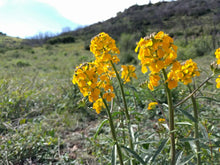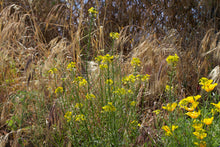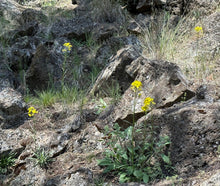
Erysimum capitatum
Western wallflower, also known as prairie rocket, Douglas wallflower or sand dune wallflower, is one plant that doesn’t live up to its name - in the best way possible! Anything but a wallflower, this lightly-fragrant beauty will add vibrant color to dry, sunny areas of your habitat garden. Since there are several naturally-occurring variants and conditions you might grow it in, visual characteristics such as height and flower color can vary widely. Generally, the long, narrow leaves are deep green, growing as a basal rosette. From late spring to midsummer, flower spires shoot up above the foliage and are blanketed in dense bunches of prolonged four-petaled blooms. And girl, nature turned the color saturation filter UP on this one, with vibrant golden hues that are typically tangerine but can vary from tones of yellow to red. Flowers are highly attractive to native pollinators like bees and butterflies and the overall plant is a host to several species of butterfly and moth lepidoptera.
- Plant type/canopy layer: deciduous, perennial (very short lifespan, but will self-sow), herbaceous plant
- Size at maturity: 0-48” tall; 0-18” wide
- Light requirements: full sun, part sun/part shade
- Moisture requirements: dry to moist soil, prefers well-drained sites
- Bloom time: March - September (April - July in Portland Metro area)
- Growth rate/ease: fast growing, moderately easy to grow
- Wildlife support: flowers attract and provide nectar to adult butterflies, such as the Painted Lady and Anise swallowtail as well as bees and other insect pollinators; mature seeds are food for insects and birds; the overall plant is a caterpillar host and larval food source for native butterflies like the Sara Orangetip butterfly and several nocturnal moths.
- Native habitat/range: relatively common growing in drier habitats, usually below 1300m, from southern British Columbia to southern California. Portland Plant List - yes.
- Special features & uses: pollinator favorite; drought-tolerant; can be used medicinally as a poultices for bronchial congestion and dried leaves/seeds in a tea to ease stomach cramps; landscape uses include ecoroofs, meadowscapes, rock gardens, pollinator gardens, and edges of woodland gardens
Gardening with Western Wallflower: Western wallflower is a joyful, pollinator-friendly option that will add quick color to sunny areas that have relatively loose soil and fast drainage; such as an exposed slope or meadowscape. It prefers dry to moist soil, is highly-drought tolerant, but occasional supplemental water during the summer months will promote even longer bloom-times, as long as the drainage is good. For the best visual impact and pollinator value, we encourage planting it in large swathes or drifts, i.e. interspersed with other flowering perennials, spaced one-two feet apart along the background of a pollinator garden. Even though it is technically perennial, western wallflower is sometimes mistakenly listed as a biennial due to its short lifespan. But don’t fret about this wallflower fading into the background, it will reseed readily if planted in favorable conditions.
Photo Credit 1 (orange flower closeup): Nikkie West, Sparrowhawk Native Plants
Photo Credits 2 & 3 (orange flowers and leaves): Karli Del Biondo, Beetles and Bees
Photo Credit 4 (orange flowering stalk in the garden) © Mary K. Hanson, some rights reserved (CC-BY)
Photo Credit 5 (yellow flowering stalks closeup): "J20160303-0076—Erysimum capitatum var angustatum—RPBG" by John Rusk is licensed under CC BY 2.0.
Photo Credit 6 ((in meadow): © Ken-ichi Ueda, some rights reserved (CC-BY)
Photo Credit 7 (yellow flowering population): © Arvel Hernandez, some rights reserved (CC-BY)
Photo Credit 8 (yellow flowering plants on rocks): © Henrik Kibak, some rights reserved (CC-BY)








